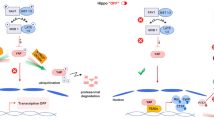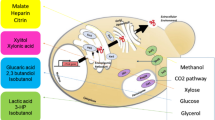Abstract
Lactate has long been credited as a by-product, which jeopardizes cell growth and productivity when accumulated over a certain concentration during the manufacturing process of therapeutic recombinant proteins by Chinese hamster ovary (CHO) cells. A number of efforts to decrease the lactate concentration have been developed; however, the accumulation of lactate is still a critical issue by the late stage of fed-batch culture. Therefore, a lactate-tolerant cell line was developed through over-expression of lactate dehydrogenase C (LDH-C). In fed-batch culture, sodium lactate or sodium pyruvate was supplemented into the culture medium to simulate the environment of lactate accumulation, and LDH-C over-expression increased the highest viable cell density by over 30 and 50 %, respectively, on day 5, meanwhile the viability was also improved significantly since day 5 compared with that of the control. The percentages of cells suffering early and late apoptosis decreased by 3.2 to 12.5 and 2.0 to 4.3 %, respectively, from day 6 onwards in the fed-batch culture when 40 mM sodium pyruvate was added compared to the control. The results were confirmed by mitochondrial membrane potential assay. In addition, the expression of cleaved caspases 3 and 7 decreased in cells over-expressing LDH-C, suggesting the mitochondrial pathway was involved in the LDH-C regulated anti-apoptosis. In conclusion, a novel cell line with higher lactate tolerance, lowered lactate production, and alleviated apoptosis response was developed by over-expression of LDH-C, which may potentially represent an efficient and labor-saving approach in generating recombinant proteins.






Similar content being viewed by others
References
Altamirano C, Paredes C, Cairó JJ, Gòdia F (2000) Improvement of CHO cell culture medium formulation: simultaneous substitution of glucose and glutamine. Biotechnol Prog 16(1):69–75. doi:10.1021/bp990124j
Andrae U, Singh J, Ziegler-Skylakakis K (1985) Pyruvate and related α-ketoacids protect mammalian cells in culture against hydrogen peroxide-induced cytotoxicity. Toxicol Lett 28(2–3):93–98. doi:10.1016/0378-4274(85)90015-3
Chong WPK, Reddy SG, Yusufi FNK, Lee DY, Wong NSC, Heng CK, Yap MGS, Ho YS (2010) Metabolomics-driven approach for the improvement of Chinese hamster ovary cell growth: overexpression of malate dehydrogenase II. J Biotechnol 147(2):116–121. doi:10.1016/j.jbiotec.2010.03.018
Chusainow J, Yang YS, Yeo JH, Toh PC, Asvadi P, Wong NS, Yap MG (2010) A study of monoclonal antibody-producing CHO cell lines: what makes a stable high producer. Biotechnol Bioeng 102(4):1182–1196. doi:10.1002/bit.22158
Cruz H, Freitas C, Alves P, Moreira J, Carrondo M (2000) Effects of ammonia and lactate on growth, metabolism, and productivity of BHK cells. Enzym Microb Technol 27(1):43–52. doi:10.1016/S0141-0229(00)00151-4
Dorai H, Kyung YS, Ellis D, Kinney C, Lin C, Jan D, Moore G, Betenbaugh MJ (2009) Expression of anti-apoptosis genes alters lactate metabolism of Chinese hamster ovary cells in culture. Biotechnol Bioeng 103(3):592–608. doi:10.1002/bit.22269
Gagnon M, Hiller G, Luan YT, Kittredge A, DeFelice J, Drapeau D (2011) High-end pH-controlled delivery of glucose effectively suppresses lactate accumulation in CHO fed-batch cultures. Biotechnol Bioeng 108(6):1328–1337. doi:10.1002/bit.23072
Han YK, Kim YG, Kim JY, Lee GM (2010) Hyperosmotic stress induces autophagy and apoptosis in recombinant Chinese hamster ovary cell culture. Biotechnol Bioeng 105(6):1187–1192. doi:10.1002/bit.22643
Hansen HA, Emborg C (1994) Influence of ammonium on growth, metabolism, and productivity of a continuous suspension Chinese hamster ovary cell culture. Biotechnol Prog 10(1):121–124. doi:10.1021/bp00025a014
Janke R, Genzel Y, Wahl A, Reichl U (2010) Measurement of key metabolic enzyme activities in mammalian cells using rapid and sensitive microplate-based assays. Biotechnol Bioeng 107(3):566–581. doi:10.1002/bit.22817
Jaskille A, Alam HB, Rhee P, Hanes W, Kirkpatrick JR, Koustova E (2004) D-lactate increases pulmonary apoptosis by restricting phosphorylation of bad and eNOS in a rat model of hemorrhagic shock. J Trauma 57(2):262–269. doi:10.1097/01.TA.0000133841.95455.73
Jayapal KP, Wlaschin KF, Hu W, Yap MG (2007) Recombinant protein therapeutics from CHO cells—20 years and counting. Chem Eng Prog 103(10):40
Jeon M, Yu D, Lee G (2011) Combinatorial engineering of ldh-α and bcl-2 for reducing lactate production and improving cell growth in dihydrofolate reductase-deficient Chinese hamster ovary cells. Appl Microbiol Biotechnol 92(4):779–790. doi:10.1007/s00253-011-3475-0
Jing Y, Zhang C, Fu T, Jiang C, Ma K, Zhang D, Hou S, Dai J, Wang H, Zhang X, Kou G, Guo Y (2014) Combination of dextran sulfate and recombinant trypsin on aggregation of Chinese hamster ovary cells. Cytotechnology. doi:10.1007/s10616-014-9774-4
Kim S, Lee G (2007a) Functional expression of human pyruvate carboxylase for reduced lactic acid formation of Chinese hamster ovary cells (DG44). Appl Microbiol Biotechnol 76(3):659–665. doi:10.1007/s00253-007-1041-6
Kim S, Lee G (2007b) Down-regulation of lactate dehydrogenase-A by siRNAs for reduced lactic acid formation of Chinese hamster ovary cells producing thrombopoietin. Appl Microbiol Biotechnol 74(1):152–159. doi:10.1007/s00253-006-0654-5
Koslowski M, Türeci O, Bell C, Krause P, Lehr HA, Brunner J, Seitz G, Nestle FO, Huber C, Sahin U (2002) Multiple splice variants of lactate dehydrogenase C selectively expressed in human cancer. Cancer Res 62(22):6750–6755. doi:10.1073/pnas.0502173102
Lao MS, Toth D (1997) Effects of ammonium and lactate on growth and metabolism of a recombinant Chinese hamster ovary cell culture. Biotechnol Prog 13(5):688–691. doi:10.1021/bp9602360
Li Y, Li Q, Wang Z, Liang D, Liang S, Tang X, Guo L, Zhang R, Zhu D (2009) 15-HETE suppresses K+ channel activity and inhibits apoptosis in pulmonary artery smooth muscle cells. Apoptosis 14(1):42–51. doi:10.1007/s10495-008-0286-6
Ma N, Ellet J, Okediadi C, Hermes P, McCormick E, Casnocha S (2009) A single nutrient feed supports both chemically defined NS0 and CHO fed-batch processes: improved productivity and lactate metabolism. Biotechnol Prog 25(5):1353–1363. doi:10.1002/btpr.238
Ozden O, Park SH, Wagner BA, Yong Song H, Zhu Y, Vassilopoulos A, Jung B, Buettner GR, Gius D (2014) SIRT3 deacetylates and increases pyruvate dehydrogenase activity in cancer cells. Free Radic Biol Med 76:163–172. doi:10.1016/j.freeradbiomed.2014.08.001
Paredes C, Prats E, Cairó JJ, Azorín F, Cornudella L, Gòdia F (1999) Modification of glucose and glutamine metabolism in hybridoma cells through metabolic engineering. Cytotechnology 30(1):85–93. doi:10.1023/a:1008012518961
Szperalski CJB, Shao Z, Kantardjieff A, Hu WS (2011) LDH-C can be differentially expressed during fermentation of CHO cells. BMC Proc 5(Suppl 8):p107. doi:10.1186/1753-6561-5-S8-P107
Tabuchi H, Sugiyama T (2013) Cooverexpression of alanine aminotransferase 1 in Chinese hamster ovary cells overexpressing taurine transporter further stimulates metabolism and enhances product yield. Biotechnol Bioeng 110(8):2208–2215. doi:10.1002/bit.24881
Templeton N, Lewis A, Dorai H, Qian EA, Campbell MP, Smith KD, Lang SE, Betenbaugh MJ, Young JD (2014) The impact of anti-apoptotic gene Bcl-2∆ expression on CHO central metabolism. Metab Eng 25(0):92–102. doi:10.1016/j.ymben.2014.06.010
Tiefenthaler M, Amberger A, Bacher N, Hartmann BL, Margreiter R, Kofler R, Konwalinka G (2001) Increased lactate production follows loss of mitochondrial membrane potential during apoptosis of human leukaemia cells. Br J Haematol 114(3):574–580. doi:10.1046/j.1365-2141.2001.02988.x
Wagner R (1997) Metabolic control of animal cell culture processes. In: Hauser H (ed) Mammalian cell biotechnology in protein production. Walter de Gruyter, Berlin, pp. 233–276
Wlaschin KF, Hu WS (2007) Engineering cell metabolism for high-density cell culture via manipulation of sugar transport. J Biotechnol 131(2):168–176. doi:10.1016/j.jbiotec.2007.06.006
Wong DCF, Wong KTK, Goh LT, Heng CK, Yap MGS (2005) Impact of dynamic online fed-batch strategies on metabolism, productivity and N-glycosylation quality in CHO cell cultures. Biotechnol Bioeng 89(2):164–177. doi:10.1002/bit.20317
Wurm FM (2004) Production of recombinant protein therapeutics in cultivated mammalian cells. Nat Biotechnol 22(11):1393–1398. doi:10.1038/nbt1026
Zhou M, Crawford Y, Ng D, Tung J, Pynn AF, Meier A, Yuk IH, Vijayasankaran N, Leach K, Joly J, Snedecor B, Shen A (2011) Decreasing lactate level and increasing antibody production in Chinese Hamster Ovary cells (CHO) by reducing the expression of lactate dehydrogenase and pyruvate dehydrogenase kinases. J Biotechnol 153(1–2):27–34. doi:10.1016/j.jbiotec.2011.03.003
Acknowledgments
This work was supported in part by grants from the National Natural Science Foundation of China (81330061), Special Project for Infection Disease and New Drug Development, Shanghai Commission of Science and Technology, and Shanghai Municipal Commission for Shanghai Leading Academic Project (B905).
Author information
Authors and Affiliations
Corresponding author
Ethics declarations
Conflict of interest
The authors declare that they have no competing interests.
Ethical approval
This article does not contain any studies with human participants or animals performed by any of the authors.
Additional information
Tuo Fu and Cunchao Zhang contributed equally to this study.
Rights and permissions
About this article
Cite this article
Fu, T., Zhang, C., Jing, Y. et al. Regulation of cell growth and apoptosis through lactate dehydrogenase C over-expression in Chinese hamster ovary cells. Appl Microbiol Biotechnol 100, 5007–5016 (2016). https://doi.org/10.1007/s00253-016-7348-4
Received:
Revised:
Accepted:
Published:
Issue Date:
DOI: https://doi.org/10.1007/s00253-016-7348-4




